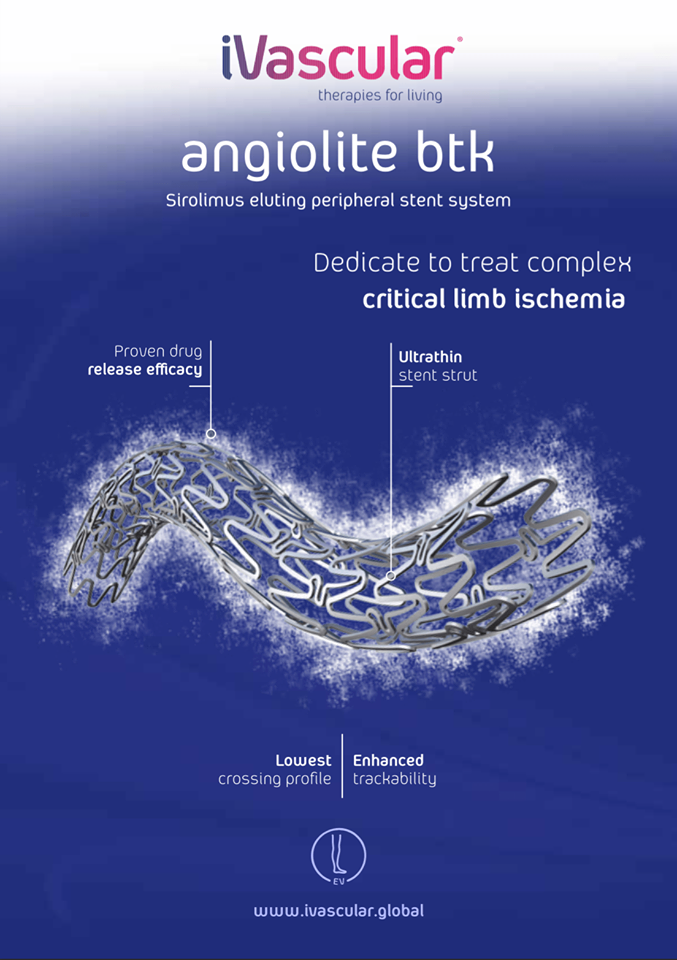Description
Description
The sirolimus-eluting peripheral stent angiolite BTK is made from a cobalt chromium alloy called L605, coated with a mix of sirolimus and last generation of biostable polymers. The stent is pre-mounted on the delivery system that will allow implantation on the lesion to treat thanks to the inflation of a balloon at the distal end of the catheter.
The stent is manufactured from a metal tube that is laser cut and subsequently subjected to various treatments that will give the surface a smooth and glossy finish. The stent design is based on a concatenation of cells in the circumferential direction that are connected to each other axially by means of links to obtain different longitudinal configurations. Moreover, the adjustment of the number of cells in the radial direction allows the stent to be expanded to different diameters. The result is an open cell design.
The stent delivery system is a rapid exchange balloon catheter, also called RX, having a single lumen configuration on the proximal part and a coaxial double lumen configuration on the distal part. The catheter has an inflatable segment (balloon) in its distal end. The balloon is designed to achieve different diameters and lengths, engaging the stent in its different configurations and covering the range of lesions to be treated. Before positioning, the balloon is folded and the stent is compressed over it. There are radiopaque markers delimiting the length of the stent and to facilitate observation under fluoroscopy. When the balloon reaches the lesion and is inflated, the stent expands against the artery. Subsequently, the balloon is deflated and removed and the stent remains permanently implanted.
The distal part of the catheter is coated with a durable hydrophilic coating to minimize friction and improve its trackability.
The inflatable segment is coated with a homogeneous mixture of the drug Sirolimus (Rapamycin) and a biostable fluoroacrylate polymer yielding a drug dose of 1.4 µg/mm2.
Features
- iVascular’s proprietary coating technology “TransferWise”. Nanotechnology drop dosage system that yields a multilayer thin coating.
- Improved coating mechanical resistance. Better adhesion to the stent. Homogeneous, durable and flexible formula.
- Triple layer coating (primer + matrix + top) to yield a controlled Sirolimus eluting profile.
- Fluorinated acrylate polymer with selective cellular activity: Prevents smooth muscle cell deposition while enhancing reendothelization.
- Specific stent design for DES: alternate spiral links and more crowns per turn for a balanced arterial coverage to assure homogeneous drug distribution.
- Faultless coating after stent expansion.
- Ultrathin strut design (75 µm) for clinical safety.
- Very low crossing profile and hydrophilic coated shaft for smooth trackability.
Indications
The device is indicated for treating chronic and acute arterial lesions in the lower limbs below the knee (BTK), as well as popliteal and infrapopliteal lesions with reference vessel diameters of between ≥2 mm and ≤4.50 mm, with the aim of increasing the internal diameter of an artery and consequently improving blood flow in the following cases:
- Severe claudication
- Critical limb ischaemia
Specifications
- Stent material: CoCr L605
- Strut thickness: 75 µm – 85 µm depending on stent diameter. Links 70 µm
- % recoil: < 5%
- % shortening at expansion: < 3%
- Drug: Sirolimus 1.4 µg/mm2
- Polymer: Biostable fluorinated acrylate
- Catheter materials: Nylon / Pebax. No latex components.
- Semi-compliant balloon
- Nominal pressure: 9 – 12 atm
- Rated Burst Pressure (RBP): 16 atm
- Average Burst Pressure (ABP): 22 atm
- 2 Pt/Ir radiopaque markers on the catheter delimiting the stent
- Guiding catheter compatibility: 5F
- Catheter’s working length: 142 cm
- Recommended guidewire: 0.014”
- Entry profile: 0.017”
- Wide size range

Clinical Support
Initial preclinical studies are required during the process of improving polymers, platforms, and drug-eluting systems for new peripheral stent designs. The objective is to analyse the efficacy and safety of the new drug eluting stent system angiolite BTK compared to conventional BMS in an experimental model with healthy porcine arteries. Angiolite BTK showed less late loss and angiographic restenosis than conventional BMS. Histologically, restenosis and neointimal area were also lower. Safety data showed that while inflammation was lower for angiolite BTK compared to BMS, endothelization stayed at equivalent rates. For further detail of the study check “Rev Esp Cardiol (Engl Ed). 2015 Jul 20” or download the file.
Angiolite BTK clinical trial: The objective of this clinical investigation is to evaluate the short-term (up to 18 months) outcome of treatment by means of angiolite BTK in patients with a bailout-DES below the knee. This prospective study involves 50 patients and is coordinated by Dr. Peter Goverde in Belgium. Primary endpoint is the safety use of angiolite BTK in procedures with bailout-stent and the absence of clinical revascularization at 12 months. Secondary endpoints are: Primary and Secondary Patency and Freedom of Major Amputation at 6, 9 and 12 months.
Package Contents
- One sirolimus-eluting peripheral stent system comprising the coated stent pre-mounted on its delivery system (balloon catheter). The stent is protected by a sheath and a stylet inserted at the guidewire lumen. The whole system is introduced into a dispenser and in a sterile bag. Finally, the bag with sterile contents is inserted into a secondary foil bag to protect it from light.
- One card with the compliance curve showing the working pressure range.
- One implantation card.
- One leaflet with instructions for use.





